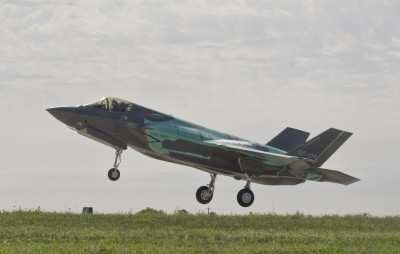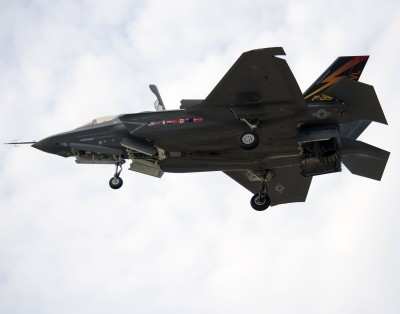First Lockheed Martin Mission Systems-Equipped Airplane Begins
Flight Tests
The first F-35 Lightning II stealth fighter with a full avionics
suite made its first flight Thursday, ushering in what will be the
most powerful and comprehensive sensor package ever to fly in a
fighter.

During the flight, F-35 Test Pilot David Nelson climbed to
15,500 feet, verified engine response at varying throttle settings,
performed a series of flight-qualities maneuvers and checked the
operation of the aircraft's mission systems. The flight out of
Lockheed Martin's Fort Worth plant began at 1004 CDT and concluded
at 1059.
"Today's flight initiates a level of avionics capability that no
fighter has ever achieved," said Eric Branyan, Lockheed Martin F-35
deputy program manager. "The F-35's next-generation sensor suite
enables a new capability for multi role aircraft, collecting vast
amounts of data and fusing the information into a single, highly
comprehensible display that will enable the pilot to make faster
and more effective tactical decisions."
The F-35's avionics, or mission systems, also process and apply
data from a wide array of off-board sensors based on land, in the
air or at sea, enabling the jet to perform command-and-control
functions while providing unprecedented situational awareness to
air and surface forces.

The F-35 BF-4, a short takeoff/vertical landing (STOVL) variant,
will begin testing with the AESA radar, EW, ICNI, ICP, GPS, INS and
HMDS, then integrate the remaining sensors as flight testing
progresses. F-35C carrier variant and F-35A conventional takeoff
and landing variant test aircraft will be similarly mission
systems-equipped, with mission systems commonality among the three
variants near 100 percent. High avionics commonality is an enabler
of rapid training, interoperability, and lower production and
support costs.
F-35 avionics already have undergone more than 100,000 hours of
laboratory testing, including sensor-fusion testing in the
program's Cooperative Avionics Test Bed, a highly modified 737
airliner incorporating the entire F-35 mission systems suite,
including an F-35 cockpit. F-35 software has demonstrated
remarkable stability, and sensors have met or exceeded performance
predictions.
BF-4 is scheduled to fly to Naval Air Station Patuxent River,
MD, where it will join three other F-35Bs currently undergoing
flight testing. BF-4's general test objectives include providing
data for mission systems Block 0.5 functionality in the F-35 flight
environment to evaluate hardware and software implementation and
integration, and providing data to support mission systems
component development.

The Block 0.5 software incorporates important capabilities,
including air-to-air search and synthetic aperture radar modes,
identification friend/foe transponder, integrated UHF/VHF radios,
electronic warfare radar warning receiver, and navigation
functions. Information is presented to the pilot through
state-of-the-art cockpit and helmet displays.
 Classic Aero-TV: VerdeGo Debuts VH-3 Hybrid-Electric Powerplant
Classic Aero-TV: VerdeGo Debuts VH-3 Hybrid-Electric Powerplant NTSB Prelim: Grumman American Avn. Corp. AA-5B
NTSB Prelim: Grumman American Avn. Corp. AA-5B ANN's Daily Aero-Linx (12.02.25)
ANN's Daily Aero-Linx (12.02.25) Aero-News: Quote of the Day (12.02.25)
Aero-News: Quote of the Day (12.02.25) Aero-News: Quote of the Day (12.03.25)
Aero-News: Quote of the Day (12.03.25)





